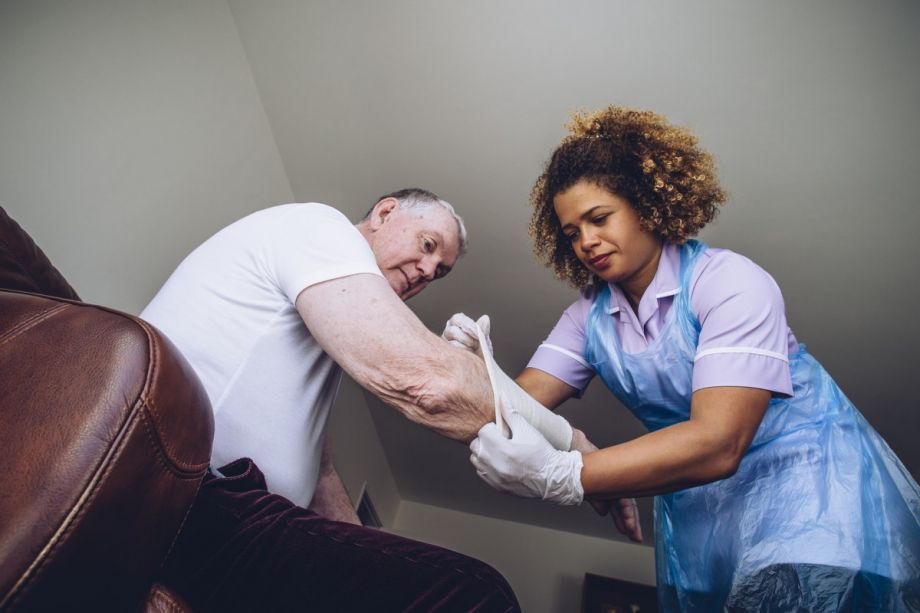Few work days go by without Jodi Sturgeon talking shop with Adria Powell. They work on different floors of the same building in the Bronx, and their staff are also in fairly constant communication with each other.
Powell is CEO of Cooperative Home Care Associates, a home health aide agency and the largest worker-owned cooperative in the country, with around 2,300 home health aides, nurses, administrative staff and other employees.
Sturgeon is president of PHI, formerly known as the Paraprofessional Healthcare Institute, a nonprofit affiliate of Cooperative Home Care Associates. The home care cooperative created PHI in part to serve as a sort of internal academy to develop and constantly update its curriculum for licensing and educating new home health aides, as well as the curriculum for continuing education, which state regulators require for home health aides to maintain their licenses.
Today, PHI partners with home health agencies, colleges and other entities across the country to provide home health aide licensing and continuing education courses. The nonprofit takes a “train the trainers” approach, training staff at other entities, often nurses or nurse practitioners, to educate home health aides.
“We continue to work closely with Cooperative Home Care Associates today in refining the curriculum, making adjustments, using them as a learning lab and bringing those practices to other employers,” Sturgeon says. “People who at one time would be in the hospital are now in nursing homes, and the people who were in nursing homes are now at home, so today there’s a lot of emphasis on particular client diseases like dementia and diabetes, and heart disease. That’s different than 20 or 25 years ago.”
COVID-19 has added to the demand for home health aides, as many are needing to call out sick when they show signs of symptoms. To help meet some of that demand under social distancing conditions, for the first time PHI’s curriculum is going almost all-digital. Through a partnership with the NYC Department of Small Business Services, PHI is working with the New York Alliance for Careers in Healthcare and the City University of New York to bring all but eight out of 100 hours of a home health aide licensing curriculum into video conference format.
With around 240 participants, the first cohort started participating in virtual sessions on June 8. Through the partnership, those who successfully complete the licensing course will be placed at one of three home health agencies serving New York City.
“We see we had an increase in the home health aide absenteeism out of fear of infection and also quarantine policies if people needed to quarantine themselves, and there was a halt to in-person, employer-based training even while the need is growing,” says Jonnel Doris, newly appointed as NYC’s Commissioner of Small Business Services. “These three employer partners say they need at least 300 home health aide workers. That’s just three partners we’re talking about and there are 900 licensed home health agencies in the city.”
The NYC Department of Small Business Services estimates that there are 150,000 home health aides working in New York City. Across the country, there are 2.3 million home health aides, according to PHI.
Home care workers — which include home health aides as well as personal care aides and certified nursing assistants — are one of the most accessible careers. Home health aides and nursing assistants are federally required to complete just 75 hours of training, with no prior experience required. (PHI’s home health aide licensing course is typically around 120 hours.) About a third (35 percent) have only a high-school diploma, and another 18 percent began, but did not complete, secondary education, according to PHI’s analysis of U.S. Census Bureau data.
The profession is also disproportionately filled by women (88 percent). According to PHI, 28 percent of home care workers are Black, 21 percent are Hispanic, 27 percent are immigrants and an estimated five percent are undocumented.
Between 2018 and 2028, PHI projects the direct care workforce will add more than 1.3 million new jobs — nearly all of which, 1.1 million, will be home health aides.
But the health care system does not put a high value on home care work. PHI estimates that home care service agencies get 70 percent of their revenue from public sources like Medicare or Medicaid, whose payment rates for various services are set by public policy.
In large part as a result of low payment rates to home care agencies, inflation-adjusted median hourly wages for home care workers were $10.33 in 2006 and $10.49 in 2016, according to PHI. While that is a few dollars more than the federal minimum wage, most home care workers don’t work enough hours to be considered full time. According to PHI, two-thirds of home care workers work part time or for part of the year, meaning home care work pays a median annual income of just $13,800, and 23 percent of home care workers live in households below the federal poverty line, compared to 7 percent of all U.S. workers.
PHI advocates for higher reimbursement rates for home care work. Better pay may help attract more people into the profession. It might help with high rates of burnout and turnover, too. In the absence of better compensation, close collaboration with Cooperative Home Care Associates means PHI can tweak and update its training curriculum to optimize for retention of existing home care workers.
“The model we’ve developed with Cooperative Home Care Associates is intentional around bringing in the right people, then providing employment support for the typical home care worker, with lots of work around demographics who is the typical worker,” Sturgeon says. “The cooperative benefits from that in that its turnover is about 18 percent compared to the industry norm of 40-60 percent.”
While it’s easy enough to move the didactic parts of the licensing curriculum online — lectures and presentations — Sturgeon says it’s the parts in-between that are difficult to replicate over video calls, and those parts often turn out to be essential for preparing home care workers. It’s about instilling confidence in skills, especially physical skills like preventing falls.
The final eight hours of the licensing course, consisting of some physical demonstration of skills, will still take place in person. In small groups, trainees will visit one of the participating CUNY locations that already has home health aide training capacity in place from before the pandemic. That’s far less time practicing in direct observation with instructors than usual, but these will be the first new home health aides licensed in the city since before the pandemic.
There is no charge to participants in this program for going through the training and licensing, but the Department of Small Business Services estimates the program costs about $2,500 per participant, including about $100 in printed materials, a small package of training equipment sent to each participant, and compensation for instructors. The funding for the partnership is coming out of the department’s existing budget for workforce development, funded by city income, sales and property tax revenues.
“It supports our city’s long-term care sector that’s been devastated by COVID, and creates a real career pathway for successful graduates,” Doris says. “These are opportunities folks are often denied because of lack of access to formal education, with a pathway into a career and even union membership, which I think is important.”
This article is part of The Bottom Line, a series exploring scalable solutions for problems related to affordability, inclusive economic growth and access to capital. Click here to subscribe to our Bottom Line newsletter.

Oscar is Next City's senior economic justice correspondent. He previously served as Next City’s editor from 2018-2019, and was a Next City Equitable Cities Fellow from 2015-2016. Since 2011, Oscar has covered community development finance, community banking, impact investing, economic development, housing and more for media outlets such as Shelterforce, B Magazine, Impact Alpha and Fast Company.
Follow Oscar .(JavaScript must be enabled to view this email address)


















